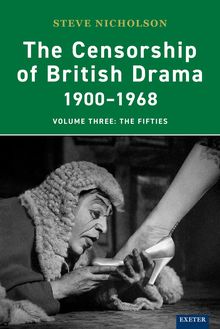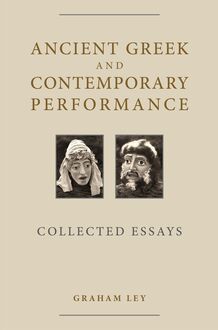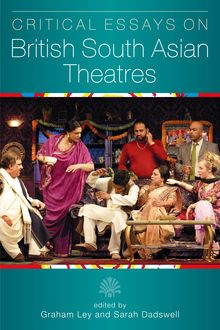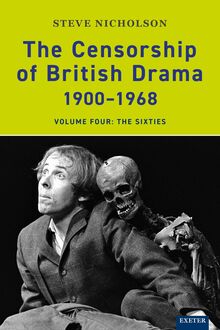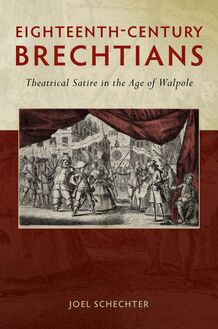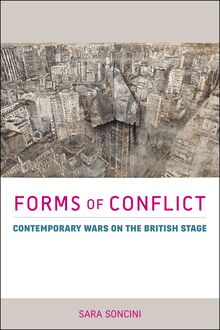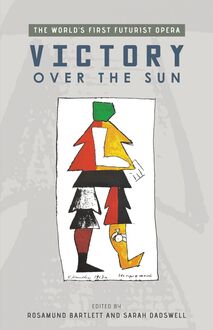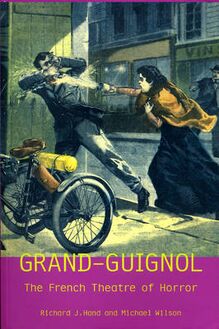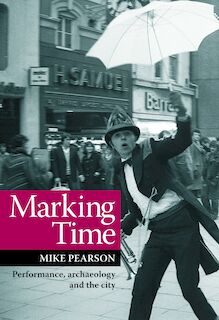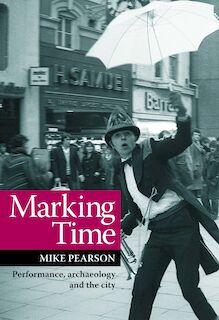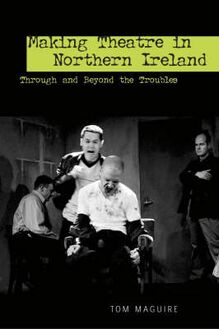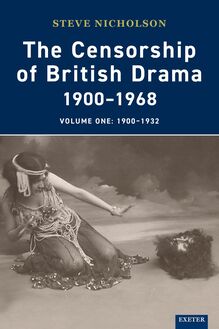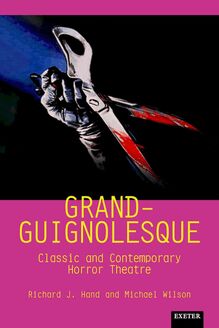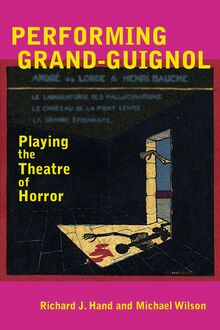-
 Univers
Univers
-
 Ebooks
Ebooks
-
 Livres audio
Livres audio
-
 Presse
Presse
-
 Podcasts
Podcasts
-
 BD
BD
-
 Documents
Documents
-
- Cours
- Révisions
- Ressources pédagogiques
- Sciences de l’éducation
- Manuels scolaires
- Langues
- Travaux de classe
- Annales de BEP
- Etudes supérieures
- Maternelle et primaire
- Fiches de lecture
- Orientation scolaire
- Méthodologie
- Corrigés de devoir
- Annales d’examens et concours
- Annales du bac
- Annales du brevet
- Rapports de stage
La lecture à portée de main
Vous pourrez modifier la taille du texte de cet ouvrage
Découvre YouScribe en t'inscrivant gratuitement
Je m'inscrisDécouvre YouScribe en t'inscrivant gratuitement
Je m'inscrisEn savoir plus
Vous pourrez modifier la taille du texte de cet ouvrage
En savoir plus

Description
The Théâtre du Grand-Guignol in Paris (1897 - 1962) achieved a legendary reputation as the 'Theatre of Horror' a venue displaying such explicit violence and blood-curdling terror that a resident doctor was employed to treat the numerous spectators who fainted each night. Indeed, the phrase 'grand guignol' has entered the language to describe any display of sensational horror.
Since the theatre closed its doors forty years ago, the genre has been overlooked by critics and theatre historians. This book reconsiders the importance and influence of the Grand-Guignol within its social, cultural and historical contexts, and is the first attempt at a major evaluation of the genre as performance. It gives full consideration to practical applications and to the challenges presented to the actor and director.
The book also includes outstanding new translations by the authors of ten Grand-Guignol plays, none of which have been previously available in English. The presentation of these plays in English for the first time is an implicit demand for a total reappraisal of the grand-guignol genre, not least for the unexpected inclusion of two very funny comedies.
1. Jack! (lui!), Oscar Metenier
2. The Ultimate Torture (La Derniere Torture), Andr de Lorde and Eugene Morel
3. The Lighthousekeepers (Gardiens de Phare), Paul Autier and Paul Colquemin
4. Chop-chop! (La Veuve), Eugene Heros and Leon Abric
5. Tics! or Doing the Deed (Apres Coup ou Tics), Ren Berton
6. In the Darkroom (Sous la Lumiere Rouge), Maurice Level and Etienne Rey
7. The Final Kiss (Le Baiser dans la Nuit), Maurice Level
8. The Torture Garden (Le Jardin des Supplices), Pierre Chaine and Andre de Lorde
9. Euthanasia (L'euthanasie), Ren Berton
10. The Kiss of Blood (Le Baiser de Sang), Jean Aragny and Francis Nelson
Sujets
Informations
| Publié par | University of Exeter Press |
| Date de parution | 17 juillet 2019 |
| Nombre de lectures | 0 |
| EAN13 | 9781905816354 |
| Langue | English |
| Poids de l'ouvrage | 2 Mo |
Informations légales : prix de location à la page 0,1500€. Cette information est donnée uniquement à titre indicatif conformément à la législation en vigueur.
Extrait
Grand-Guignol
The Théâtre du Grand-Guignol in Paris (1897–1962) achieved a legendary reputation as the ‘Theatre of Horror’, a venue displaying such explicit violence and blood-curdling terror that a resident doctor was employed to treat the numerous spectators who fainted each night. Indeed, grand guignol has entered the English language to describe any display of sensational horror.
The first part of this book, ‘An Introduction to the Grand-Guignol’, reconsiders the importance and influence of the Grand-Guignol within its social, cultural and historical contexts. It is the first attempt at a major evaluation of the genre as performance: since the theatre closed its doors forty years ago, its plays have been generally overlooked by critics and theatre historians. The authors give full consideration to practical applications and to the challenges presented to the actor and director.
The second part of the book, ‘Ten Plays of the Grand-Guignol’, provides outstanding new translations of a selection of Grand-Guignol plays. The presentation of these plays in English is an invitation to theatres to revive them as well as an implicit demand for a total reappraisal of the Grand-Guignol genre, not least for the unexpected inclusion of two very funny comedies.
Richard J. Hand and Michael Wilson are Principal Lecturers in Drama at the University of Glamorgan.
Exeter Performance Studies
Exeter Performance Studies aims to publish the best new scholarship from a variety of sources, presenting established authors alongside innovative work from new scholars. The list explores critically the relationship between theatre and history, relating performance studies to broader political, social and cultural contexts. It also includes titles which offer access to previously unavailable material.
Series editors: Peter Thomson, Professor of Drama at the University of Exeter; Graham Ley, Lecturer in Drama at the University of Exeter; Steve Nicholson, Head of Theatre Studies and Principal Lecturer at the University of Huddersfield.
The façade of Théâtre 347 (formerly the Théâtre du Grand-Guignol), cité Chaptal, Paris, at the time of writing this book (Collection of Hand and Wilson)
First published in 2002 by University of Exeter Press Reed Hall, Streatham Drive Exeter, Devon EX4 4QR UK www.exeterpress.co.uk
Reprinted 2003, 2006, 2007, 2008, 2010
© Richard J. Hand and Michael Wilson 2002
© The rights of Richard J. Hand and Michael Wilson to be identified as authors of this work have been asserted by them in accordance with the Copyright, Designs & Patents Act 1988.
For information on the performing rights in the plays translated in this book see the note on p. 80.
British Library Cataloguing in Publication Data A catalogue record of this book is available from the British Library
Paperback ISBN 978 0 85989 696 2 Hardback ISBN 978 0 85989 695 5 ePub ISBN 978 1 90581 6354 PDF ISBN 978 0 85989 917 8
Typeset in Sabon 10/12pt by Exe Valley Dataset Ltd, Exeter
To Sadiyah, Shahrazad, Jayne, Phillip, Gemma and Hannah
Contents
List of Illustrations
Preface
P ART O NE: AN I NTRODUCTION TO THE G RAND -G UIGNOL
1 An Historical Outline of the Grand-Guignol
2 The Topography of Horror: Location and venue
3 Acts of Horror: Performing in the Grand-Guignol
4 Technical Aspects of Grand-Guignol Practice
5 Issues of Audience and Reception at the Grand-Guignol
P ART T WO: T EN P LAYS OF THE G RAND -G UIGNOL
A Note on the Translations
Jack (Lui!) by Oscar Méténier
The Ultimate Torture (La Dernière Torture) by André de Lorde and Eugène Morel
The Lighthouse Keepers (Gardiens de phare) by Paul Autier and Paul Cloquemin
Chop-Chop! or The Guillotine (La Veuve) by Eugène Héros and Léon Abric
Tics, or Doing The Deed (Après Coup! . . . ou Tics) by René Berton
In the Darkroom (Sous la lumière rouge) by Maurice Level and Étienne Rey
The Final Kiss (Le Baiser dans la nuit) by Maurice Level
The Torture Garden (Le Jardin des supplices) by Pierre Chaine and André de Lorde
Euthanasia (L’Euthanasie ou le Devoir de tuer) by René Berton
The Kiss of Blood (Le Baiser de sang) by Jean Aragny and Francis Neilson
Bibliography
Filmography
Index
Illustrations
Cover illustration ‘Vengeance au vitriol’, Le Petit Parisien (Collection of Hand and Wilson)
Frontispiece The façade of Théâtre 347 (formerly the Théâtre du Grand-Guignol) (Collection of Hand and Wilson)
1 ‘Un Crime Monstrueux commis par deux enfants’, Le Petit Journal , 26 December 1909, 416 (Collection of Hand and Wilson)
2 Lionel Bercier (M. Krauss) in André de Lorde and Alfred Binet’s L’Homme mystérieux ( Monde Illustré, number 2799, 1910, 32) (British Library)
3 Christina (Vera Clouzot) in Les Diaboliques (Henri-Georges Clouzot, 1954) (Collection of Hand and Wilson)
4 Louise (Alida Valli) in Les Yeux sans visage (Georges Franju, 1959) (Collection of Hand and Wilson)
5 Philippe in Maurice Level and Étienne Rey’s Sous la lumière rouge ( Monde Illustré, number 2831, 1911, 10) (British Library)
6 Raymond and Lionel in de Lorde and Binet’s L’Homme mystérieux ( Monde Illustré, number 2799, 1910, 31) (British Library)
7 Henri and Jeanne in Level’s Le Baiser dans la nuit ( Monde Illustré, number 2917, 1913, 16) (British Library)
8 Philippe and Didier in Level and Rey’s Sous la lumière rouge ( Monde Illustré, number 2831, 1911, 9) (British Library)
9 ‘The Acid Test’, The Haunt of Fear , Issue 11, EC Comics, January 1952 (EC Publications, Inc/William M. Gaines, Agent, Inc.)
Preface
The phrase ‘grand-guignol’ has entered the language as a general term for the display of grotesque violence within performance media, but it originates in a specific theatre down an obscure alley in Paris. The Grand-Guignol 1 was a remarkable theatre. For more than six decades it thrilled its audiences with a peculiar blend of horrific violence, the erotic and fast-paced comedy. In its time it achieved international notoriety and became one of the most successful tourist attractions in the French capital.
It is, therefore, all the more extraordinary that, both in its lifetime and since its demise, the Grand-Guignol has been virtually ignored by academics and today has the status of one of the world’s great forgotten theatres. It is not difficult to lay the blame for this neglect at the door of institutional conservatism and general disdain in the past for the serious study of popular theatre in academic circles. For many years the Grand-Guignol was simply deemed unworthy of serious consideration and the very recipe for its success with the public was sufficient to secure its dismissal by theatre historians. It is, therefore, to be welcomed that recent years have witnessed a growing interest in popular culture; the horror genre, in its many forms, has now entered the arena of scholarly debate. This book has been prepared in that context and, partly at least, in response to the lack of material available on the Grand-Guignol, particularly to the English-speaking reader.
The Grand-Guignol emerged at a crucial and exciting time for theatre. It was conceived in the nineteenth century, directly from the groundbreaking work of André Antoine and his fellow naturalist radicals at the Théâtre Libre. In fact, it grew up to become a child of the twentieth century, emerging as a complex and seemingly contradictory mixture of theatrical traditions and genres characterized by its use of both horror and comedy plays, incorporating melodrama and naturalism, and going on to reflect the influence of Expressionism and film. Yet at its heart it always remained a popular theatre and, more crucially, a modern theatre. If the dawn of the twentieth century was a critical period in the development of European theatre, then the same can be said for the horror genre itself. As Paul Wells states:
As the nineteenth century passed into the twentieth, this prevailing moral and ethical tension between the individual and the sociopolitical order was profoundly affected by some of the most significant shifts in social and cultural life. This effectively reconfigured the notion of evil in the horror text . . . in a way that moved beyond issues of fantasy and ideology and into the realms of material existence and an overt challenge to established cultural value systems.
(Wells 2000, 3)
The Grand-Guignol only became what it did because it emerged when it did and where it did. When talking of a ‘Theatre of Horror’ one might imagine the monster-iconography and Gothic extravaganzas (ironic or otherwise) on display in Richard O’Brien’s The Rocky Horror Show (1975), Andrew Lloyd-Webber’s Phantom of the Opera (1986), and even Anne Rice’s Interview with the Vampire (1976). But as a realist form that never strays far from a grounding in Zola-inspired naturalism, ‘ Grand Guignol requires sadists rather than monsters’ (Carroll 1990, 15). Although the Grand-Guignol steers well clear of all things supernatural, it pushes the human subject into monstrosity, extrapolating, as it were, la bête humaine into le monstre humain . André de Lorde sums up this aspect of the Grand-Guignol when he writes in the preface to La Galerie des monstres (1928), ‘we have a monster within us—a potential monster’ (quoted in Pierron 1995, 1339). 2 The psychological motivation of the Grand-Guignol protagonist/antagonist—in the comedies as much as the horror plays—is dictated by primal instincts, or unpredictable mania, the plots obsessed with death, sex and insanity and exacerbated or compounded by grotesque coincidence or haunting irony.
Aside from a few books on the subject, the Grand-Guignol’s most substantial surviving legacy is the collection of scripts, housed at the Bibliothèque de l’Arsenal, fifty-five of which are contained in Agnès Pierron’s Le Grand-Guignol (1995). There also exists a number of photographic stills, documentary footage, press cuttings, programme notes and eye-witness accounts. The most useful of these are the memoirs of Pau
-
 Univers
Univers
-
 Ebooks
Ebooks
-
 Livres audio
Livres audio
-
 Presse
Presse
-
 Podcasts
Podcasts
-
 BD
BD
-
 Documents
Documents
-
Jeunesse
-
Littérature
-
Ressources professionnelles
-
Santé et bien-être
-
Savoirs
-
Education
-
Loisirs et hobbies
-
Art, musique et cinéma
-
Actualité et débat de société
-
Jeunesse
-
Littérature
-
Ressources professionnelles
-
Santé et bien-être
-
Savoirs
-
Education
-
Loisirs et hobbies
-
Art, musique et cinéma
-
Actualité et débat de société
-
Actualités
-
Lifestyle
-
Presse jeunesse
-
Presse professionnelle
-
Pratique
-
Presse sportive
-
Presse internationale
-
Culture & Médias
-
Action et Aventures
-
Science-fiction et Fantasy
-
Société
-
Jeunesse
-
Littérature
-
Ressources professionnelles
-
Santé et bien-être
-
Savoirs
-
Education
-
Loisirs et hobbies
-
Art, musique et cinéma
-
Actualité et débat de société
- Cours
- Révisions
- Ressources pédagogiques
- Sciences de l’éducation
- Manuels scolaires
- Langues
- Travaux de classe
- Annales de BEP
- Etudes supérieures
- Maternelle et primaire
- Fiches de lecture
- Orientation scolaire
- Méthodologie
- Corrigés de devoir
- Annales d’examens et concours
- Annales du bac
- Annales du brevet
- Rapports de stage
